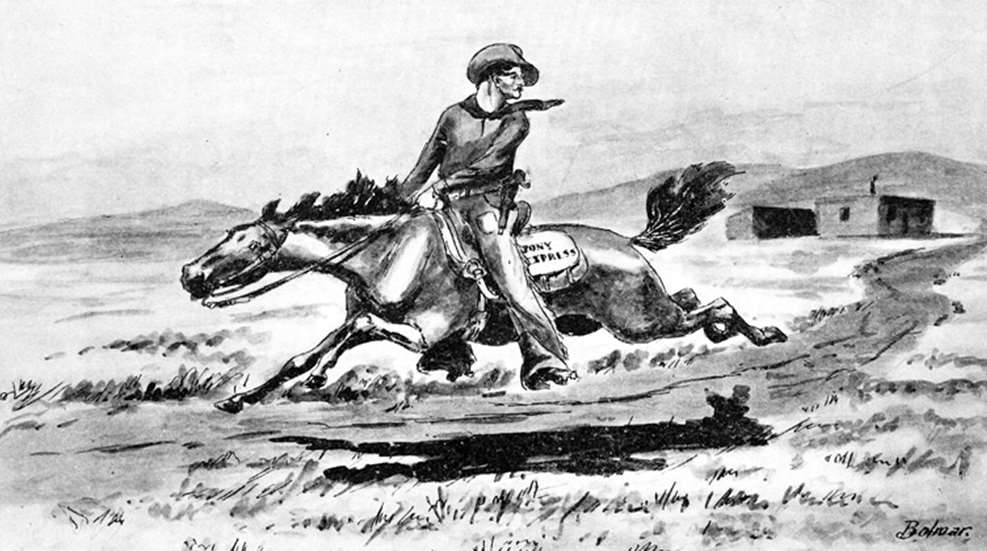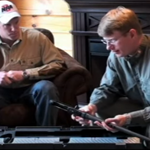
Wanted: young, skinny, wiry fellows, not over eighteen. Must be expert riders, willing to risk death daily. Orphans preferred. Wages $25 per week. Apply, Pony Express Stables, St. Joseph, Missouri.
In 1860, when a good wage for an unskilled laborer was a dollar a day, imagine a teenager making $100 per month for just riding a fast horse (which is what most young bucks were doing at that time in their lives for fun anyway). Of course, to collect such a generous paycheck you had to survive, and that meant eluding Indians, enduring extreme weather and avoiding a host of other deadly hazards along the trail.
The legendary Pony Express was in business just 19 months—eventually replaced by the transcontinental telegraph—but during that short time it became a lasting icon of the American West. It was a rapid-delivery mail service that promised delivery from St. Joseph, Missouri, to Sacramento, California, (1,900 miles) in just 10 days. That was considered lightning speed for those times, as wagon trains headed west took four to six months to cover the same distance.
Teenage boys were sought because the weight limit for riders was 125 pounds, making it easier on the horses. Some 400 horses were used by 120 riders who rode as quickly as possible from station to station, a total of 184 stopping points spaced about every 10 miles. Depending upon the terrain, horses were ridden at a fast trot, canter or gallop of around 10 to 15 miles per hour. At times, though, on level ground, they were spurred into a full gallop of up to 25 miles per hour. A rider would come racing into a station, swing down from his winded mount, grab the mail pouch from the saddle, throw it on a fresh horse and ride away again, all within just a few seconds.
The mail pouch was called a mochila, from the Spanish for pouch or backpack. It fit over a saddle and was held in place by the weight of the rider. The saddle horn and cantle (rear of the saddle) projected through holes in the mochila, cut to size. Attached to the corners of this leather skirt were four cantinas, hard-leather boxes where the bundles of letters were carried, padlocked for safety.
Riders rode around the clock, in good weather and bad, relieved by another rider every 75 to 100 miles. At times, during emergencies, a rider might be required to ride a double shift, resulting in being in the saddle for 20 hours or more. Because of weight concerns, all that riders were permitted to carry for their personal comfort and safety was some water and a six-shooter. And Pony Express management made it clear that if it came to a crisis situation along the trail, the mail was more important than both the horse and the rider.
One rider who found himself in just such a crisis situation was Billy Tate, only 14 years old. He was pounding the trail in Nevada near Ruby Valley when he was spotted and chased by a band of Paiute Indians on horseback. Tate decided to leave the trail and try losing the Indians in some large rocks. Unfortunately, his strategy failed and the Indians eventually found him. During the ensuing shootout Billy supposedly killed as many as seven warriors before the remaining Indians killed him. Tate’s body was found full of arrows but not scalped, a sign that the Indians respected the bravery of this young enemy.
Another well-known rider was Robert (Pony Bob) Haslam. Born in 1840 in London, he arrived in the United States just in time to hire on with the Pony Express. And as with Billy Tate, Haslam had a run-in with Indians. He received the eastbound mail from Friday’s Station in California, but when he reached Buckland’s Station his relief rider was so spooked by rumors of hostile Indians in the area that he refused to ride. Haslam agreed to take the mail on to Smith’s Creek, for a total distance of 190 miles without rest.
After nine hours of sleep, Haslam then retraced his route carrying the westbound mail—including a copy of President Abraham Lincoln’s inaugural address. But at Cold Springs he discovered that Indians had raided the station, killing the station keeper and running off the horses. Haslam had no choice but to keep going, and during the extended ride was shot through the jaw with an Indian arrow, losing three teeth. But he finally arrived back at Buckland’s Station alive, making his 380-mile round-trip the longest in Pony Express history.
The most famous Pony Express rider of all was none other than 15-year-old William Frederick Cody. In Wyoming, Cody made the longest non-stop ride from Red Buttes Station to Rocky Ridge Station and back when he found that his relief rider had been killed. The distance of 322 miles, over one of the most dangerous sections of the entire Pony Express trail, was completed in 21 hours and 40 minutes, requiring 21 horses.
After his stint with the Pony Express, Cody turned to buffalo hunting to make a living, and he was good at it. During an eight-month period while providing meat for the Kansas-Pacific Railroad, he shot 4,280 of the large, shaggy beasts—as many as 69 in one day—a feat that earned him the nickname “Buffalo Bill.” It’s the same man who in 1883 founded Buffalo Bill’s Wild West, and for years toured the United States, Canada, England, and Europe with an extravagant entourage of authentic cowboys and Indians, real buffalo, and featuring Annie Oakley as a sharpshooter.
It’s interesting to note that, in the end, after delivering some 35,000 letters, the Pony Express was a financial failure. It grossed $90,000 but lost $200,000. Nevertheless, the image of a young rider on a fast horse galloping across the Great Plains of the American West has endured into the 21st Century.






































